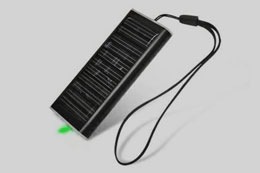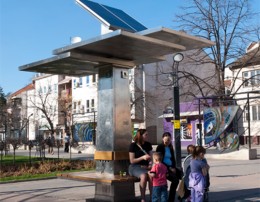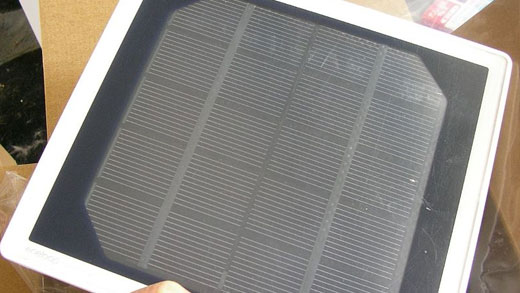The benefits of solar-powered chargers
Imagine you’re camping or trekking up on the hills, and you get stranded. But you’ve forgotten to recharge your iPhone. Or even if you’ve fully recharged it, at the end of the day or the next your phone’s batteries will be drained if you’re continuously using it. You have your power bank too that will keep you going if you’re still in the outdoors for a day or two (or three days), but what if it’s running out of power as well? Of course, finding an electric outlet in the thick of the forest is obviously out of the question.
The sun is shining bright once you walk out of the thick forest and into the wide, open meadows, or the riverside. The sky is clear, the sun is brightly shining. You rummage into your bag and you fish out your solar-powered battery charger. You plug your charger’s USB cable into your phone, PSP, or camera, and then flip your charger’s solar panel to face skyward. This is probably a good moment to sit back and relax, go read a book, or go fishing. Or even while waving your phone high up in the air and trying to catch a signal.
Had we been in the same situation about a decade back, we would have been really lost and out of luck. Or even if we have survived the apocalypse, where else can we get power when all electric supplies have been depleted and shut down?
These days, many companies are manufacturing solar-powered batteries and battery chargers that range from car to AA batteries. Now there are a lot of solar-powered chargers to fuel the batteries of our cell phones, smartphones, game consoles, cameras and MP3 players as well as laptops and tablets. The good thing about solar chargers is that you’ll get unlimited power to re-charge your gadgets, especially if your place you’re staying has plenty of sunshine. Most of the solar-powered battery chargers are portable.
Meanwhile, you can also read about the benefits of going green as a business here.
The power of the sun discovered and utilized

Although mankind has been aware that the sun has been providing heat and light to Earth for billions of years, it’s only recently that we have figured out how to make use of the sun’s power.
It was in 1954, where researchers at Bell Laboratories created the photovoltaic cell, which later turned into solar cells that transformed the heat of the sun into a usable source of energy.
In 1956, the first solar cells were released commercially, but the pricing was way out of reach of the mass consumers. For instance, a one-watt solar cell cost $300, a price that was considered too steep for most ordinary people at the time.
By the late 1950s and the early 1960s American and Soviet space programs had begun using solar-powered satellites. From then on, solar power had become a standard in supplying power to satellites.
In the 1970s, further research — led by oil firm Exxon — helped pave the way to make solar power more accessible to ordinary consumers. This caused the prices of solar cells to slash down from $100 per watt to only about $20 per watt. Solar cells proved to be helpful for several off-shore oil rigs as they provided power to their warning lights especially during the evening.
Many people, particularly those who are concerned with the environment or simply want to cut back the costs incurred from using traditional sources of energy, have slowly adopted and welcomed the use of solar energy to give light to their homes (at night) and power their appliances. There are even solar powered water heaters for showers and swimming pools. And if you want to find out the top 10 must-have home office gadgets and accessories, open the given link.
The arrival of solar energy in the mobile era
In 2008, Japanese companies StrapyaNext and Tokyo Coil Engineering claimed they were the first to invent a solar battery charger for cell phones. The solar portable charger, which came in the form of a phone strap, was priced at US$19 but it was available only for Japanese phones.
Nowadays, you’ll be overwhelmed by the assortment of mobile solar chargers on the market. Most standard chargers and power banks can be easily replaced by mobile solar chargers. Really, there are a plethora of solar chargers out there available at popular prices. But “cheaper” doesn’t necessarily make a reliable solar battery charger, so make sure to buy one that is both affordable and dependable — in other words, worth your every penny. Also, make sure that the solar-powered charger you buy is compatible with whatever device you’re using.
Mobile solar chargers have solar panels, which contain solar cells. When you place the mobile solar charger under direct sunlight, the solar cells convert the sun’s heat into energy which will be then stored in the charger’s battery. Compared to standard power banks and small device chargers, mobile solar chargers typically take longer before they become full and ready for use. Plus, if you want more power, you will need a bigger solar charger.
Now, more and more people are using mobile phones and gadgets in the outdoors. This has caused a demand for portable solar chargers for these devices, and so more and more companies are manufacturing portable solar chargers. Fitted with solar panels, these portable sun-powered chargers have become the preferred choice especially for those who love to go outdoors, or those who have outdoor/field occupations such as mountain rangers.
The examples of these solar chargers in popular use today include:

1. Small portable chargers that are created and designed to recharge different ranges of mobile phones, smartphones, iPods or any other MP3 players or portable audio gadgets.
2. Solar chargers that feature fold-out models, designed to place on your car’s dashboard.
3. Solar torches, many of which come with a secondary means of gathering other sources of energy (such as kinetic energy).
4. Public solar chargers that are installed at public places and venues such as parks, squares, and streets where people can re-charge their gadgets for absolutely no charge.
5. Window solar battery chargers, which you can attach to windows inside your homes and vehicles.
6. Solar panels that are fitted to your bag or backpack.
7. There are also portable solar generators with built-in AC inverters. These gas-free generators can power a wide range of devices from smartphones and laptops to things as big as TVs and refrigerators. However, you have to buy a separate solar panel to power them, since most solar generators do not include those.
The sun provides an unlimited, clean and renewable source of energy to power our devices and electronics. It’s really high time to take advantage of the power of the sun! You can also read our post about How to Make Money By Selling Articles by clicking the link.


